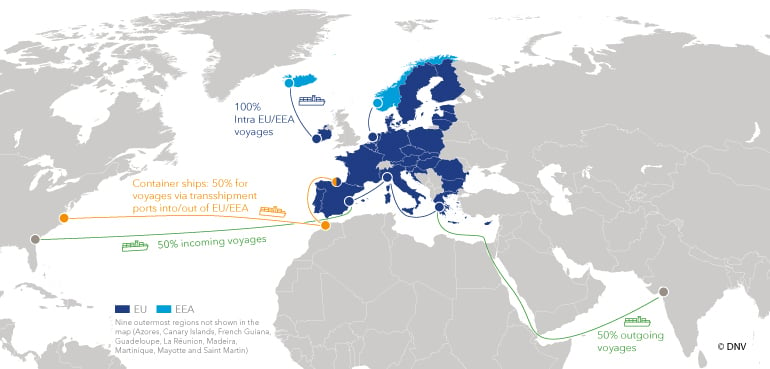Get to know FuelEU Maritime
FuelEU Maritime is a regulation that will be implemented from 1 January 2025 and which has been adopted by the EU to increase the share of renewable and low-carbon fuels in the fuel mix of international maritime transport within the EU. Discover the details of this regulation below - and find out how DNV can support you.
How does FuelEU Maritime work?
FuelEU Maritime sets requirements on the annual average GHG intensity of energy used by ships trading within the EU or European Economic Area (EEA). This intensity is measured as GHG emissions per energy unit (gCO2e/MJ) and, in turn, GHG emissions are calculated in a well-to-wake perspective. The calculation takes into account emissions related to the extraction, cultivation, production and transportation of fuel, in addition to emissions from energy used on board the ship.

The baseline for the calculation is the average well-to-wake GHG intensity of the fleet in 2020: 91.16 gCO2e/MJ. This will start at a 2% reduction in 2025, increasing to 6% in 2030, and accelerating from 2035 to reach an 80% reduction by 2050.

Good to know: The GHG intensity requirement applies to 100% of energy used on voyages and port calls within the EU or EEA, and 50% of energy used on voyages into or out of the EU or EEA.

In addition, it requires passenger and container ships to use onshore power supplies at all relevant ports from 2030, when at birth for more than two hours. Exceptions to the requirements to connect to shore power are explained in our FAQ section. From 1 January 2035, container and passenger ships must connect to shore power in all ports where shore power is available.
A plan of action for shipowners?
- Submit a FuelEU Monitoring Plan to an accredited verifier, such as DNV. This plan should outline how you intend to monitor and report emissions for each ship in your fleet. This should be completed by 31 August 2024.
- Start reporting key data related to FuelEU Maritime from 1 January 2025. This data includes fuel consumption, carbon emissions, and distance travelled.
- If relevant, have each individual ship’s FuelEU partial reports verified at least one month after change of company.
- Submit the individual ship’s FuelEU reports by 31 January 2026.
- By 30 April 2026, have the compliance balance approved in the FuelEU Maritime database.
- By 30 June 2026, have the FuelEU Document of Compliance on board. This is also the penalty payment deadline.
To find out more about how you can comply with FuelEU Maritime, click on the Compliance tab.
Rely on DNV for FuelEU Maritime support
DNV is ready to assist shipowners at every stage of your FuelEU Maritime journey. This starts with our user-friendly and efficient FuelEU Monitoring Plan online form, which is available to all companies and contains everything shipowners need to ensure they are fully prepared for the upcoming implementation of FuelEU Maritime.
Verification of FuelEU Emissions Report
As an accredited verifier for FuelEU Maritime, DNV will provide verification services for the partial FuelEU Emissions Report starting in 2025, and for the annual FuelEU Emissions Report beginning in 2026.
Our fully digital service has a built-in interface that allows customers to generate a report on compliance with all regulations (EU and UK MRV, IMO DCS and FuelEU Maritime).
Data can be uploaded daily using API transfer via Veracity Integrated Partners. While DNV verifies the accuracy of each vessel's data for the entire year, users can also take advantage of a pre-verification data quality check to help them identify missing data or errors.
Explore how DNV can assist you with FuelEU Maritime by visiting our Service tab.
More on FuelEU Maritime
On-demand webinar: Commercial implications of FuelEU Maritime and EU ETS - New insights
Get access to the recording and slidedeck
FuelEU Maritime white paper for download
Learn more about the requirements, compliance strategies, and commercial impacts
What are the commercial implications of FuelEU Maritime?
Listen to our 20-minute podcast and get valuable insights
How can FuelEU’s new pooling mechanisms be put into practice?
Listen to our 26-minute podcast and get valuable insights
Related topics and services
MRV (EU and UK)
Visit our topic page
EU ETS – Emissions Trading System
Visit our topic page
IMO DCS – Data Collection System
Visit our topic page
CII – Carbon Intensity Indicator
Visit our topic page
Emissions Connect
ADVANCE from raw data to continuous business control
Decarbonization Plan
A long-term decarbonization strategy to ensure cost-effective fleet compliance.
